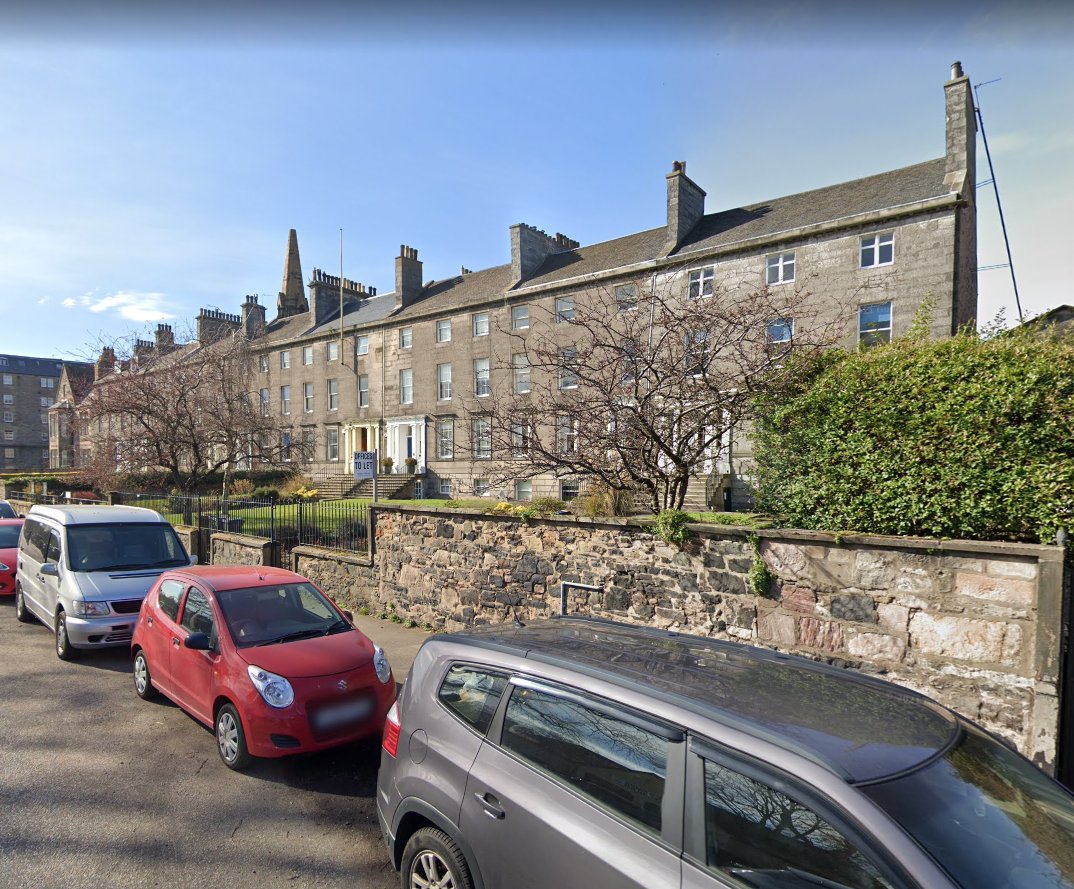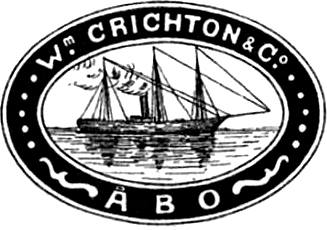
Väinämöinen was built in Finland's primary shipyard, which had the somewhat un-Finnish sounding name of Crichton-Vulcan. One of its predecessor companies was the Turku yard Wm. Crichton & Co., named for its Leith-born owner
https://twitter.com/TheDreadShips/status/1518707182161780736
Crichton made his fortune as an engineer in Finland, then part of Imperial Russia. He bought a half share in his former employer, Cowie & Eriksson, and renamed it. If you think Cowie doesn't sound very Finnish either, then you're right. David Cowie hailed from Montrose. 

William was born in South Leith in 1827 to George Crichton Esq. and his wife Margaret Gifford Allan, known as Gifford. They lived in one of the fine Georgian villas of John's Place. George was a wealthy shipowner, and this was the corner of Leith where wealthy shipowners lived. 

George came from money and was the son of Alexander Crichton of Woodhouselee and Newington, coachmaker to the Prince of Wales. His older brother (William's uncle) Sir Alexander Crichton was a famous doctor of the time, physician to Czar Alexander I of Russia. More of that later.
George spent some time in the Royal Navy and had the rank of Lieutenant, but it was on land where he made his own fortune, as a shipowner. He introduced one of the first steamships to Leith, the imaginatively named "Tug" of 1817, which plied the Forth coast.
The Port of Leith at that time was not in a good state of upkeep and access was strictly tidal. In 1820 the entrepreneurial George proposed a new pier west of Newhaven that could be used at all tide states. This would become the "Pier of Suspension" (📷Edinburgh City Libraries) 

Better known as the "Trinity Chain Pier", it was built quickly, opening on August 14th 1821 to a design by Captain Samuel Brown RN. It was owned by the Trinity Pier Co., of whom George was a director and was 10 foot above high water and 627 feet long.
The pier served the east coast steamers but it never really caught on, and was superseded by improvements to the Port of Leith. George Crichton was coincidentally a commissioner of Leith Docks (📷 Edinburgh City Libraries) 

The chain pier fell into something of a state of disrepair and served out its days as a swimming station, with changing huts erected at the end and served by special bathers' trains and cable cars (📷 Edinburgh City Libraries) 



At the head of the pier was a waiting room for the steamers and a toll house (access 1d). It was replaced by a public house, which also fulfilled the former functions (🗺️OS Town Plans, 1849 & 1893, NLS) 



The pub was rebuilt (and survives to this day) but the pier was not and the remains were demolished. 

George Crichton prospered, even if his pier did not, and was a director of the London, Leith, Edinburgh & Glasgow Shipping Co. a Commissioner of Police, councillor of the Royal Landing Club, a reformist and vocal defender of Leith's independence from Edinburgh. 

He died in September 1841, leaving behind the not insubstantial fortune of £8,167 (after his creditors were settled) - about £901k in today's money.
This takes us back to George's son, William Crichton. The third son, he followed in his older brothers footsteps and went into a career in engineering. He was 14 when he finished school and his father died. His brother Alexander got him a position at Scotts' of Greenock. 

After that position was completed, his other brother Edward got him into the Shotts Iron Company (📷Rosser1954, Wikimedia) 

He then went to Robert Napier & Sons in Govan, one of *the* names in the country for shipbuilding and marine engine building at the time. When he left in 1848 he was aged just 21 but already had a most impressive CV for an aspiring young engineer.
William now went to sea to get practical experience, and served as engineer on one of the ships of his father's old company (the London, Leith, Edinburgh & Glasgow Shipping Co., where he had relations on the board of directors), the "Royal Victoria". 

After a season on the Royal Victoria, he spent his winter working on his draughtsman and design studies, before sailing the next season with the Napier-engined "Isabella Napier" of the Continental Steam Navigation Co. between Leith, London and Hamburg. 

William's big break came unexpectedly in 1850 when a letter arrived from his fellow Scotsman, David Cowie of Cowie and Eriksson - marine engineers in Turku, the Grand Duchy of Finland. Cowie invited William to join on a 3 year contract as a supervisor.
William jumped at the chance, Russia was then *the* place to be for an aspiring naval engineer as the Imperial power was playing catchup with France and Britain and desperately trying to expand and modernise its navy and its merchant marine.
Besides, his uncle Sir Alexander was physician to the Czar and cousin Sir Archibald William Crichton was also in the medical service to the Czar's family, so he already had connections to help him on his way in the new land.
William's first job in Finland was to supervise the construction and installation of the steam engines of the new frigate "Rurik" being built by Cowie & Errikson for the Russian navy. 

Crichton fell ill and was nursed by Cowie's wife. It was during this time he met her brother, Samuel Owen Jr., son of Samuel Owen Sr. who had helped industrialise Sweden (and where Eriksson and Cowie had worked and met).
It was through Owen he met Annie Elizabeth Owen, and the two would be wed in 1854. They would have 12 children together. But before he could marry, William had to finish with his work on the Rurik, which completed in 1853.
With the Rurik launched and his 3 years with Cowie & Eriksson completed, William took up a new opportunity through Owen with Fiskars (the company known for orange handled kitchen scissors and who may have made your garden shears) to help establish a foundry in Helsinki. 

But the matter of a war in Crimea got in the way and he was arrested in St. Petersburg as a possible enemy agent. Fortunately he was able to drop the name of his uncle Sir William to the chief of police. Instead of being sent to Moscow, he was released into Sir William's care.
His uncle assured his protection and put him above suspicion, and through his connections William got a place with Izhorskiye Zavody, a state-owned engineering works in Kolpino, St. Petersburg. William was able to repay Samuel Owen Jr. by getting him in too. 

William set about his new job with gusto, and after the war was over travelled frequently back to England to appraise himself of the latest designs and technology, bringing them back to Russia to improve his company's engines.
For his efforts in modernising their naval engineering the appreciative Russians presented him with a St. Stanislaus Ribbon and golden medal in 1860 (📷Smithsonian, of a silver medal) 

In 1862, William was called back to Turku by a letter from Erik Julin. Julin had bought Eriksson's shares of Cowie and Eriksson and Cowie was ready to sell his. Would William consider buying those shares and becoming his partner and lead engineer in the company? 

William said yes, and bought up the shares for 32,810 Silver Roubles. The new company became William Crichton & Co and William wasted no time in expanding its offerings into shipbuilding. 

With solid finances, Julin's business sense and William's engineering prowess and Imperial connections, the company prospered. By the 1870s the Turku yard employed 400 and was building mainly small screw tugs and coastal vessels and auxiliary engines.
Crichton expanded shipbuilding by taking control of the Turku Old Shipyard and modernising it for production of steel vessels. With greater liabilities, it was converted into a limited organisation, with 2/3 of the shares owned by Crichton and 1/3 by Julin.
The company went from strength to strength and became the largest employer in Turku. To ensure Imperial orders it maintained a dedicated "commercial councellor" in St. Petersburg, to handle the delicate negotiations and backhanders required to get state work.
Crichton continued to modernise and enlarge the works, until his death in 1889 aged 62. None of his 12 children wanted to take on the operation, so his shares were sold off to his deputy, John Eager, and to banks and Russian nobility.
The company continued to prosper and increasingly started to build small warships for the Russian navy. In 1898 it built 26 "Sokol" torpedo boats to a design by Yarrow & Co. - who at the time were on the Thames but would later become a big name on the Clyde. 

Chasing these orders from the Russian navy saw Crichton's take on a yarm in Okhta, St. Petersburg. This investment would ultimately be its undoing as it incurred large debts and its poor performance resulted in large penalty contract clauses.
In 1906, tensions between Moscow and the Finnish Grand Duchy saw the Russian Navy cancel all contracts with Finnish yards. This hit Crichtons hard and they incurred further losses from which they never recovered. By 1913 they declared super-duper bankruptcy with enormous debts. 

But that was not the end for the Leith name of Crichton in Finnish shipbuilding - two of the company's biggest creditors (and shareholders) were the Dahlström brothers, and they restarted the yard in Turku under the name AB Crichton in 1914. 

AB Crichton managed to pick up subcontracting work for the Russian Navy which kept it going during the war years, before it was again hit by the Russian exit of WW1 and "February Bourgeois Democratic Revolution"
It struggled on with some orders from the new Finnish state - including a pair of gunboats "Karjala" (picture) and "Turunmaa" which would go on to serve in Finland's wars with the Soviet Union in the 1940s until the 1950s. 

But the post-WW1, post-revolution, post-independence and post-civil war recession hit AB Crichton very hard, building its last ship in 1924. But a merger with its neighbour and rival, AB Vulcan, to form Crichton-Vulcan Oy, saved its name.
Thus it was that Crichton-Vulcan a company with a half-Scottish name and heritage, was Finland's largest shipyard and was awarded orders in 1927 for two new 3,900 tonne coastal defence armoured ships for the Finnish navy, "Ilmarinen" and "Väinämöinen" (pictured). 

Both ships served in the wars with the Soviet Union, Ilmarinen hit mines in September 1941 and sunk with the loss of 271 men from a crew of 401. The survivers were sardonically termed "Ilmarisen uimaseura" (Ilmarinen's Swimming Club)
Väinämöinen was a persistent thorn in the Soviet side, and they expended great efforts to sink her, succeeding in July 1944. Except thanks to herculean camouflage efforts by the Finns, they actually sank the German anti aircraft ship "Niobe" instead. 

Väinämöinen survived, but after the Continuation War, she was handed over to the Soviets as a reparation. She spent 6 years in service with the Baltic Fleet as "Vyborg" (a Soviet ship sunk by a Finnish submarine - built by Crichton-Vulcan) before being scrapped in 1966🔚
(footnote, this is why there is a street in Turku on the waterfront called Crichtoninkatu or Crichtongatan). 



• • •
Missing some Tweet in this thread? You can try to
force a refresh












